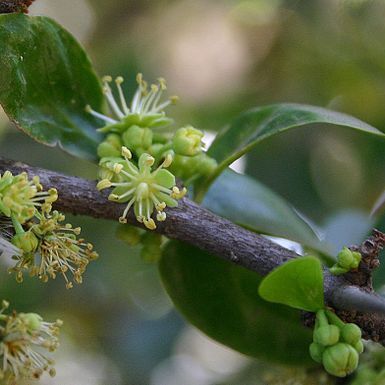Shrubs or trees, unarmed, or often with simple or compound spines on trunk and branches, and simple axillary spines on branchlets, dioecious or andromonoecious, i.e. the ♂ plant bearing occasionally a few bisexual flowers and fruits. Leaves alternate, sometimes fascicled on much reduced lateral shoots, generally persistent, rarely deciduous, entire, denticulate or crenate, exstipulate, petiolate, with 1 or 2 basal or suprabasal and a few upper spreading pairs of nerves, with fine pellucid points visible against strong light in a number of species. Flowers greenish to yellowish, rarely white, solitary or in short racemes, these generally reduced to rather few-flowered fascicles; pedicels with small basal bracts. Calyx-lobes (3–)4–6(–7, very rarely –9), free almost to the base, subimbricate to practically valvate, variously pubescent on both faces, sometimes set with sessile or stipitate marginal glands, sometimes accrescent in later stages. Male flowers: stamens 10–50(–80), inserted on a rather fleshy receptacle, with several irregularly arranged small disk-glands between; filaments filiform; anthers dorsifixed. Rudiment of ovary absent. Female flowers: calyx-lobes as many as (rarely –12) and similar to those of the ♂, often slightly larger, persistent and ± recurved in fruiting time. Staminodes rarely, stamens very rarely present. Ovary surrounded at the base by a cupular or annular disk (lobed according to the number of the calyx-lobes), unilocular or incompletely 2–4(–8, rarely more)-locular; placentas 2–4(–8, rarely more), each with 1 or 2(–6) ovules; styles 2–8(–20, rarely –40), divergent, channelled, stigmata ± lobed and papillose. Fruit a fleshy berry. Seeds few, or occasionally up to 12, ellipsoid, rather flattish, embedded in a pulp; testa coriaceous, glabrous, hairy, or sometimes woolly.
More
Female flowers often solitary in the axils or in fascicles of 2–4; calyx 4–8-lobed almost to the base, persistent and sometimes accrescent in fruit, sometimes bordered with stalked glands; petals 0; disk undulate or lobed or subentire; ovary sessile on the disk, 1–2-locular or occasionally imperfectly 2–8-locular with up to 8 placentas; each placenta with 1–6 ovules; styles 2–8, divergent.
Male flowers fasciculate or in short racemes; calyx (3) 4–7-lobed almost to the base, lobes valvate or almost so, variously pubescent or tomentose; petals 0; stamens 12–?, inserted on a sub-fleshy receptacle and alternating with minute, often pubescent glands.
Leaves alternate, simple, entire, denticulate or crenate, exstipulate.
Seeds few or occasionally up to about 12, glabrous or hairy.
Shrubs or trees, unarmed or spiny.

